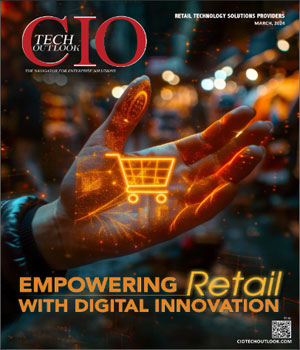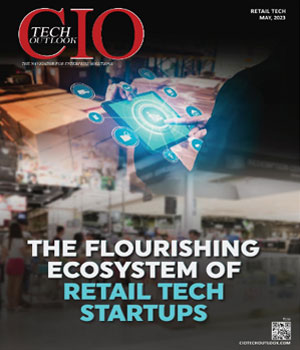
Paving the Way for Technology First Retail
Abhrasnata Das | Friday, 05 August 2022, 14:07 IST
 Vinod Kapote, Head - IT at Trent Ltd. (Trent also operates Westside, a retail fashion chain), in an interaction with the CIOTechOutlook, shares his insights on the retail industry. He touches upon the challenges associated with data collection, digital transformation, omni-channel supply chain and security breaches, and suggests measures for overcoming them.
Vinod Kapote, Head - IT at Trent Ltd. (Trent also operates Westside, a retail fashion chain), in an interaction with the CIOTechOutlook, shares his insights on the retail industry. He touches upon the challenges associated with data collection, digital transformation, omni-channel supply chain and security breaches, and suggests measures for overcoming them.
The global smart retail market is expected to expand at a CAGR of more than 27% till 2028. How is the retail industry of India developing in terms of technology adoption?
The pandemic has propelled the growth of technology adoption in India. Taking a look at the retail industry, we note that the consumers are now increasingly demanding a technology that helps them interact with us through various forums. The overall development has created a demand for technology intervention in the retail industry.
On the other end, the retail players have also geared up for the same. Today, every organization in India is looking forward to enhancing the consumers’ experience by bringing everything to their fingertips. Moving forward, although there will be different layers of adoption that each organization will have to go through depending on their state, a positive shift toward technology is being noted with every player striving to develop into a tech first company.
In order to prioritize digital in the customer journey and ensure maximum business efficiency, it is imperative to identify and implement the right technologies. How should retail businesses strategize to attain an effective digital transformation?
In order to attain an effective digital transformation, every organization must at first understand its state of business, and try to build the technology stack accordingly. An organization like us that is witnessing growth at a much faster pace than in the past requires technology that can be on par with the growth.
To begin with, organizations need to create an end-to-end integrated digital platform that will harness the power of all the new age technologies. This platform will aid the organization in collecting the necessary data such as customer information and product information, thereby helping the firms generate significant insights like the buying behavior. However, developing a digital platform does not conclude that the organizations will be having one single application keeping track of every operation. It may also refer to having layers of applications working in tandem on a single platform. This in turn will help the business develop an ecosystem that assures customers the best brand experience.
A study by Deloitte found that 71% of consumer data was inaccurate, and by not having the right data or data segmentation to know the customers, retailers risk losing business to the competition. How can this be addressed?
The implementation of conventional Pen-and-Paper Personal Interview (PAPI) approach of data collection in the retail industry has been the biggest reason behind data inaccuracy. As the consumers fill their personal details manually, they often end up providing inaccurate data. Moreover, as the retailers are not able to study or analyze the non-digital format, they seldom use it; thereby causing a loss of valuable information.
To address this situation, there has to be a digital intervention to ensure the collection of authentic and accurate data. The digital data collection method will further help to confirm that the customer is comfortable sharing the information and can provide the information at any place, not only in the physical store. With the presence of the authentic and accurate data, the retailers can take actionable decisions and nudge the customers with multiple offers.
Furthermore, with the industry approaching to provide personalized service, it is imperative to collect authentic and correct information. Hence, multiple digital interventions in data capturing mechanisms can solve this problem far better than doing the delta work around it.
When a business transitions to omni-channel model, the previous technological infrastructure can’t ensure accurate inventory and order management across all channels, leading to a failure in omni-channel execution. How can a hassle-free transformation to an omni-channel supply chain be achieved?
Omni-channel is a disruptor both in terms of technology and business practices. In essence, it means fusing the physical and digital worlds to provide the client with the best of both worlds. That being said, in these kinds of initiatives, it is imperative that the organizations start small, learn fast and expand faster.
Starting small is the key here, because working with a bigger set of fulfillment centers brings along the risk of developing a larger challenge that can adversely impact the organization. Hence, it is imperative that organizations start with a small experiment, understand the underlined challenges, fix them and move forward. Furthermore, with the amount of expertise that the organization builds in-house while understanding the process challenges both in terms of customer experience and internal processes, makes it easier to expand faster.
When it comes to expanding digital infrastructures, one of the most prevalent challenges faced by retailers is safeguarding against security breaches. How can effective cybersecurity be attained?
With massive digital expansion coming into picture, cyber security has evolved into a bigger challenge for the industry. This is because cyber attack not only leads to monetary or time loss, but it also significantly taints the reputation of a company and brand.
Hence, to develop a secure infrastructure, the organizations need to create a system or framework in place that keeps the infrastructure updated with the evolving cyber threat landscape. For example, we at our organization use the NISD framework, which is a standard framework available in the industry. We need to align ourselves to that framework, which tells us and gives us the basic guidelines in place on what exactly needs to be done in terms of the security deployments and the security actions. It further categorizes the guidelines into primarily three parts - preventive maintenance, incident management, and reporting.
Today, all the organizations handle chunks of customer data that are important to be protected. So, having a framework in place and deploying tools and technology around these three areas is the key for security to start with.
How do you foresee the retail industry evolving in the near future? What role is technology going to play in that?
Today, we note a sea change in the retail industry in terms of technology adoption, and this is going to be evolving for all the players in the market. The cutting edge technologies like omni-channel solutions are set to create a major disruption in the industry. We also note a rising number of brand experience related technologies available in the market. There are now a lot of technologies that are able to provide in-depth analytics, helping us better understand the customer behavior and trends.
With AI and ML hitting the Indian market and maturing like big data; it is going to be a crucial time for the retail industry. On the other hand, we also have Metaverse that is expected to be another big game changer for organizations like us. Hence, in a nutshell, it is going to be quite exciting in the future.
CIO Viewpoint
Paving the Way for Technology First Retail
By Abhrasnata Das
Predictive Analytics In Supply Chain Management
By Ajay Yadav, Head It (North), Arshiya Rail Infrastructure
Never Let The Good Crises Go Into Waste,...
By Ashok Jade, CIO, Shalimar Paints
CXO Insights
Maneuvering the Digital Transformation in Retail
By Janifha Evangeline
Smart Retail Converting Shop Visitors To Customers
By Dr. Dinesh Chandrasekar, VP, Chief Solutions & Innovation Head, Pactera
Importance Of Differentiated Customer Experience




.jpg)


.jpg)
.jpg)




